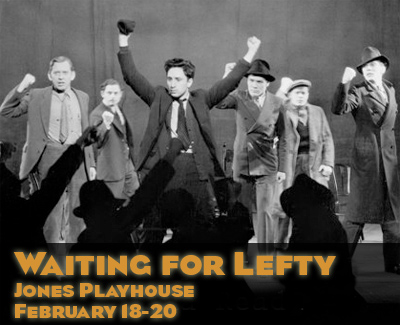"Waiting for Lefty" by Clifford Odets
( Looking Up at Down readings February 18-21)
Some of the most influential theatre artists of the twentieth century, men and women who were instrumental to the development of theatre and film in America, passed through or were once associates of The Group Theatre. The Group was a new idea when it formed: a rag-tag collection of talented young thinkers and artists, living together and making theatre collectively, and involved talents like Harold Clurman, Stella and Luther Adler, Lee Strasberg, Elia Kazan, Franchot Tone, Sanford Meisner, and a playwright named Clifford Odets. Odets made his first big splash in 1935, when two of his best plays opened. One was a full-length play called Awake and Sing! and the other was a little one-act piece about a taxi drivers’ strike, Waiting for Lefty.
Lefty is a landmark in the history of American theatre, and continues to be produced today, despite its blatant pro-union propaganda and the distance time has placed between the unique lyric of Odets’s dialogue and contemporary speech. Like many legends, the story of Lefty’s conception is one of inspired artistic productivity. As Clurman tells the story in The Fervent Years, his memoir of the Group Theatre, Odets came to him one night with an idea for a one-act play that he’d been mulling over, about taxi drivers trying to decide whether or not to go on strike. Hearing that the New Theatre League was looking for plays, Odets wanted feedback and Clurman encouraged him. However much preparation Odets may have already invested into the play is a matter of some speculation. In Clurman’s narrative, however, Odets set to work immediately—and emerged three days later with Waiting for Lefty.
The play borrows its structure from a popular American theatre tradition – employing the central "host" structure (utilizing the entire troupe) and the vignettes (played by just a few members of the troupe) of the minstrel show. Lefty begins at a union meeting of taxi drivers; the members are waiting for their missing leader, the aptly-named Lefty, to show up. A corrupt union boss lurks at the edges of the stage, smoking a cigar, and trying to dissuade the workers from striking. As various members of the union argue about their reasons for striking, vignettes show the hard life that low wages and long hours create for taxi drivers and their unfortunate families. The play builds to a fever pitch as the scenes of outrageous and unfair conditions build, and when the unionized drivers learn at the end of the play that Lefty isn’t coming and has been killed, they rise up in anger and call for a strike, encouraging the audience to join them.
The play was a hit. Opening January 5, 1935 at the old Civic Repertory Theatre on Fourteenth Street in New York City, Clurman recalls that within minutes the audience was laughing with knowing delight: taxi drivers in New York had gone on strike the previous February. It was a magical night in the theatre. Clurman remembers that “the actors no longer performed, they were being carried along as if by the exultancy of communication such as I have never witnessed in the theatre before. Audience and actors had become one” (148). At the end of the play, when the actors called from the stage, “Well, what’s the answer?” the rapt audience “Strike! Strike!” “It was the birth cry of the thirties,” Clurman wrote, “Our youth had found its voice.” Lefty moved to Broadway later that spring, opening at the Longacre Theatre on a double bill with another Odets piece, his less-successful anti-Nazi Till the Day I Die. The Group offered tickets ranging from 50 cents to $1.50, drastically reducing prices so that Lefty would be accessible to the very masses it represented and spoke both for and to. Odets took the role of Dr. Benjamin in the Broadway production, and admiring audiences hailed him on opening night with an ovation.
Lefty is Communist propaganda par excellence. As Joseph Wood Krutch observed in his review for The Nation, “the pace is swift, the characterization is for the most part crisp, and points are made, one after another, with bold simplicity.” Krutch also recognizes that the simplicity that powers Lefty meant that its characters were caricatures, that its dramatic world was strictly black-and-white. And yet, Odets managed “soap box oratory” deftly, creating such a powerful, brief impression that many would construe the politics as Odets’s own (memoirs from Group members at the time agree that Odets was actually torn in his politics and ultimately unable to commit to the Communist cause, despite his idealistic appreciation of its utopian visions for the future). The force of Odets’s writing is that, while it was openly acknowledged as propaganda, not art, his characters were nevertheless irresistibly real, and their plight raised the ire of many an audience as productions of Lefty proliferated across the nation. Drawn into sympathetic identification with the strikers, even Krutch, who acknowledges the lack of subtlety in Odets’ characters in Waiting for Lefty, nevertheless proclaims that the strikers were “so real … that when the play is over one expects to find their cabs outside.”
Copyright (c) 2009, Sarah Guthu
"Waiting for Lefty "
By Clifford Odets
Directed by Andrew Tsao
February 18-20, 7:30 pm; February 21, 2:00 pm
The Floyd and Delores Jones Playhouse | 4045 University Way NE
For more information and to buy tickets, see the UW School of Drama website.

